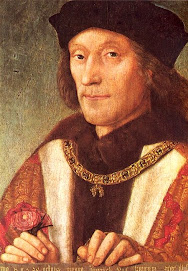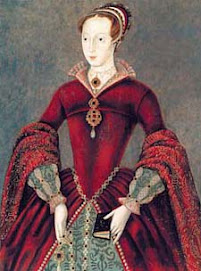Friday 8 May 2009
Was there a Mid Tudor Crisis?
A Mid-Tudor Crisis?" - The Agenda For Debate
1. Royal Minority and Female Rule:
Such a framework was potentially unstable and automatically elevated the role of the Council in politics. It tended to stimulate factionalism at Court as leading councillors jockeyed to assume the offices of Protector or Governor. Key to politics of 1550s is the relationship of the leading councillors to the monarch, and the internal politics of Privy Council and Parliament;
In the case of Somerset's protectorate (1547-9), the crux was not only that the duke arrogated the style of Protector to himself, but in addition pursued a financially catastrophic policy of warfare in Scotland and France;
A coup was contrived by John Dudley, duke of Northumberland (October 1549). It illustrated how personal Tudor monarchy remained at the death of Henry VIII. In order to capture Edward VI's government, Northumberland had literally to take possession of the person of the king. Politics became a struggle waged at Court for possession of the king's body;
Mary (1553-58) longed to preside over a 'consensus' government, but the reality is that she had to dictate to her Council each of the three major policies of the reign: her marriage to King Philip, the reunion with Rome, and the declaration of war with France. The weakness of her political system lay in the making of policy decisions, not their implementation. Her Privy Council was administratively effective once it had been informed which policy was Crown policy;
Mary was an extreme Catholic, who was assailed by Protestant exiles with objections to her rule on the grounds of religion and gender. The Protestant exiles invoked resistance theory;
The issue of female rule was complicated by Mary's marriage and relationship with Philip I, who quickly began to exert political power despite the terms of the marriage treaties, and this raised hackles in Parliament.
2. Edward VI (1547-1553):
Protector Somerset
Somerset leads an evangelical clique some of whom adopted the more radical alternatives, but Somerset for political reasons takes a bipartisan approach focused on attack on sacramentaries to keep the centre on board while advancing Protestantism by stealth.
Edward VI is Josiah purifying by stealth. No definitive statement issued on Eucharist until it was safe to do so. Schizophrenia in Somerset's approach to rites and doctrine explained by politics and diplomacy.
Duke of Northumberland
Carries on evangelical Reformation by fair means or foul (Cranmer). Eucharistic process 1548-53 is seamless, and did not depend on Somerset or Northumberland.
Focus of Jane Grey plot was originally Protestant male succession. Device would have worked if English politics confined to the Council chamber. Edward died before parliamentary confirmation could be obtained. (NB 3rd Act of Succession and Henry VIII's will amount to a written constitution.)
Was Reformation a success story?
Large-scale absenteeism in the Edwardian and Marian churches (but were absentees the same people in both reigns, and why were they absent?).
Regional variations and polarities: progress of Protestantism in localities?
Commonwealth aspirations: kingdom of God in this world (Bucer) is a fundamental Reformation critique of works theology. Spilled over into the socio-political sphere and underpinned popular politics.
Climax of 1549: populist evangelical reform turns into fiestas and camping revolts: the triumph of carnival over Lent (romantic notion).
Ordinary people (Kett's followers) believe they could influence the future, and when the government (Somerset) appeared to agree, a time of infinite possibilities seemed to have arrived.
Focus on 'liberty' in Christ, but has social and subversive implications: clerical marriage, and divorce (by 1548). If marriage was not a sacrament, then divorce feasible (hence fame of Askew).
Radicalism leads to emphasis on discipline: popular activism besmirched the cause. Cranmer sticks to vestments and rubrics of 'order and decency'.
3. Reign of Philip and Mary (1553-1558):
Politics and Religion
Splits in Council and Court;
Marriage treaties approved (December 1553); marriage to Philip II (July 1554);
Revolts timed for March 1554. Wyatt's rebellion (Kent) - some leniency against those captured;
Religious policy. Royal supremacy and Uniformity acts repealed in October 1553 - contested votes. Reconciliation with Rome delayed until November 1554;
Cardinal Pole and the papal dispensation - problem of ex-religious lands;
Catholic renewal and Counter-Reformation? 'Peace' and unity was the initial policy and public platform;
Persecution followed only after the failure of persuasion: Marian exiles; 287 martyrs; resistance theory;
Paul IV revoked Pole's commission (April 1557). Massive problem of ex-religious lands;
Financial policy: retrenchment and recoinage. Book of Rates revised. But subsidy settled at 3s. 4d. in the £. Corporate management of finance by Privy Council. Exchequer reform of 1554;
Acts for reform of the militia (1558);
French war (1557-8). Battle of St Quentin (1557). Loss of Calais (1558);
Mary and Pole die November 1558. What was the religious balance in 1558? Were the British Isles Catholic, Protestant or non-committal?
4. Progress of Protestantism:
Protestantism remained a minority religion, but was beginning to become entrenched in certain localities, e.g. the South-East, part of East Anglia, Kent, Sussex, Essex, Bristol, Colchester, Coventry, above all London (say 40% by 1553). However in the Lancashire and the north there were few Protestants, and relatively few in the south-west or even the Midlands outside the towns, e.g. Bristol, Gloucester;
The official Edwardian Reformation (Prayer Books of 1549, 1552) were primarily a paper tiger outside London, which became the 'storm centre' for Protestantism (Brigden);
Edwardian Protestantism was fragile and imposed from above. The Reformation was also linked to fiscal exactions since 1530s. Hence it was fairly easy to achieve reunion under Mary apart from issue of ex-religious lands and confiscation of lands of Protestant exiles;
In this sense Catholicism is tenacious (but popular Catholicism may not be the same thing as papalism and Counter-Reformation Catholicism. NB Mary's quarrels with Paul IV: the queen invoked the 'privilege of England'!).
Mary's reunion with Rome proceeds, but there were no religious wars. Most people keep their heads down, or else go abroad.
5. The Economy and Society:
Trend of rising population since 1520 hit by influenza epidemic (1555-9). The population drops by 200,000, or by 6 per cent;
Impact of market forces in agriculture. The people became casualties of price inflation caused by currency debasements, increased rents, and food shortages;
A dip in the European trade cycle exacerbated these economic problems;
Harvest failure causes outbreaks of famine in 1555-7.
Tuesday 13 January 2009
Subscribe to:
Posts (Atom)






